Seven Questions Over Breakfast
with Edwin Fotheringham
 June 10th, 2009 by jules
June 10th, 2009 by jules
 First of all, I don’t want to embarrass him, but I’d like to take this interview with illustrator Edwin Fotheringham, pictured above, and use it as an example for all future interviewees of how to do a Q & A, my friends. As I tell folks when I do these seven-questions-over-breakfast interviews, I blog on the side. On the side, that is, of my work-work and spending time with my children. So, I send the same questions out to everyone. I wouldn’t be interviewing someone in the first place if I didn’t love his or her work and know a lot about it, but if I customized everyone’s questions all the time, I’d never have time to do any interviews at all. So, I always say: Take these general questions and run with them and show us who you are and what your work is about. And boy howdy, did Edwin (who also goes by “Ed”) do that. And for that I thank him.
First of all, I don’t want to embarrass him, but I’d like to take this interview with illustrator Edwin Fotheringham, pictured above, and use it as an example for all future interviewees of how to do a Q & A, my friends. As I tell folks when I do these seven-questions-over-breakfast interviews, I blog on the side. On the side, that is, of my work-work and spending time with my children. So, I send the same questions out to everyone. I wouldn’t be interviewing someone in the first place if I didn’t love his or her work and know a lot about it, but if I customized everyone’s questions all the time, I’d never have time to do any interviews at all. So, I always say: Take these general questions and run with them and show us who you are and what your work is about. And boy howdy, did Edwin (who also goes by “Ed”) do that. And for that I thank him.
Secondly—and I’ll keep this short so that we can get right to his interview—I’m very happy he stopped by for a breakfast chat, because I am really crazy in love with his art. He has illustrated two children’s titles thus far in his career, after doing a lot of really fabulous editorial work, which he’s been doing for over fifteen years. (If you visit his site, you will be rewarded with lots of art.) I have enthusiastically yammered about these two children’s titles here at the blog already. Since he talks about them below and I have some art from them, I’ll skip summarizing them, except to say: Ed has wowed the critics, wowed readers, and wowed me. As Betsy Bird put it this week in her halfway-mark Newbery and Caldecott predictions, “his fame has been steadily rising. His technique is superb. His style well-suited to the picture book genre.” (Right. That marks the seven-skerjllionth time I’ve quoted Fuse recently, but she really knows her picture books.) School Library Journal described his art work in his second illustrated title, Shana Corey’s Mermaid Queen, as “glorious.” Yeah. That, too.
Let’s get right to it. For breakfast this morning, Ed’s going to have some coffee with me. And that’s because “I don’t usually eat breakfast,” he told me, “but I do drink coffee. I make lunch for my exceptional and talented kids (Joe, 8, and Anna, 11) and myself (Ed, 44) in the morning, eat scraps of cheese and meat, feed the dog the other scraps of cheese and meat, and have whatever smoothie is left in the Vita-Mix from my most beautiful spouse, Becky (ageless), and the kids. The lunch I make for myself consists of three sandwiches, which are mostly consumed before lunch-time. I ride my bike to my studio each day, and am pretty much famished when I arrive. So…my breakfast consists of my lunch, but it is not brunch, in either content or company.”
Let’s get the basics from Ed while we wait for our coffee to brew . . .
7-Imp: Are you an illustrator or author/illustrator?
Edwin: I am an illustrator. I haven’t yet felt the urge to create something with my sole authorship, and I’m not going to do it until the urge is so great that it can’t be ignored. I have enjoyed (to date) being part of the children’s pictorial literary triumvirate consisting of the author, the illustrator, and the editor. I have felt, in my case, that being separated from, and objectively criticized by, the other branches is beneficial to the final product. There’s nothing as creatively stifling as a dysfunctional marriage to one’s own work. That said, I’d love to take all the credit (and/or abuse) someday.
7-Imp: Can you list your books-to-date?

Edwin:
- What To Do About Alice? by Barbara Kerley…Published 2008, Scholastic Press.
- Mermaid Queen by Shana Corey…Published 2009, Scholastic Press.
- The Extraordinary Mark Twain (According to Susy) by Barbara Kerley…To be published 2010, Scholastic Press.
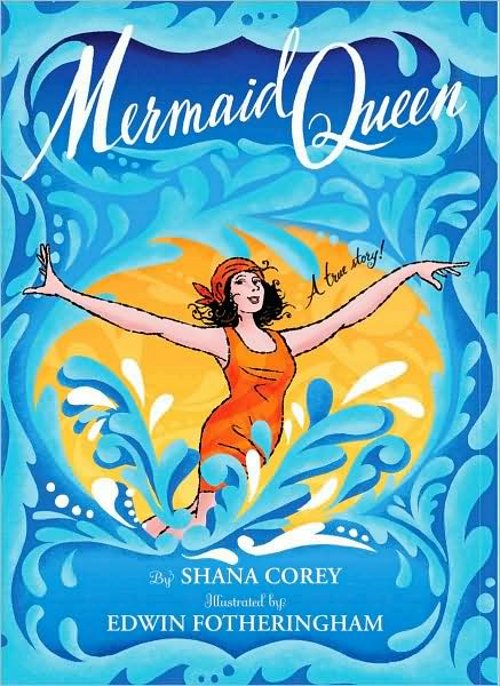
7-Imp: What is your usual medium, or -– if you use a variety -– your preferred one?
Edwin: I use a computer to make my pictures. That’s an ugly thought to many people, I understand, so I will try to pacify the dissenters as best I can. Here goes…
Once upon a time, there was a young, idealistic illustrator named Ed, who drew pictures using a mono-printing technique first developed by a now-deceased artist of some repute named Andy. The technique involved inking a piece of paper with a bead of wet ink along a sketched line, then blotting the wet ink with a second piece of tape-hinged paper. The print on the hinged paper, which is always reversed, became the final line art. Watercolor and gouache were applied to make color. Sometimes, especially when using gouache (as it is opaque), the line art had to be applied (printed) over the color. This seemed backwards and inefficient to the young illustrator, who liked to color inside his lines. A mistake meant a full re-do. “Not good,” said the (sometimes lazy) illustrator. Alas, there was no other method to get the same result, as far as he knew, so he continued on. Much foul language was heard in the adjoining studios.
What to Do About Alice?: How Alice Roosevelt Broke the Rules, Charmed the World, and Drove Her Father Teddy Crazy!
(Scholastic, 2008)
“Alice ate up the world!”
Sometimes, a magazine editor from New York would look at one of Ed’s illustrations and not understand what it meant, for it was not literal enough. The editor would ask that the green sea be made blue, for the sea is always blue. Full re-do. “Not #@*$! good,” said the young illustrator. He made the sea blue, which entailed making entirely new art, and realized that quite some time had passed. It had become very close to final call for the last FedEx shipment from the airport. Ed got into his car and drove just as fast as he could to the airport. A tall sailboat was sailing down the murky river. Honk! went the sailboat. Ding, ding, ding! went the drawbridge. Up it went. Ed had to stop the car. The sailboat passed, the drawbridge finally closed, and Ed continued, very quickly and quite sweatily, to the airport. He entered the FedEx office and was informed that he was too late. The nice woman said that DHL might still accept packages bound for New York, so Ed scurried four doors down. DHL, indeed, did take his precious 8 a.m. express cargo — and his money. Relieved, Ed went home. The next morning, Ed called the magazine in New York at 9 a.m. to see that they had received his 8 a.m. express shipment. They had not. The magazine was going to print that afternoon. They were not impressed. Neither was Ed. Something had to change*. (*DHL no longer provides domestic package delivery, so remember: don’t upset me.)

One day, upon arriving in the morning, Ed noticed his studio neighbor was staring at what looked like a television screen. She just stared and stared, mostly with a furrowed brow. Ed wondered what this contraption was and what his neighbor, also an illustrator, was using it for. It was called a computer, and it could do things that Ed felt might, someday, change the whole world (and possibly DHL). He found out that one could send messages with it, with pictures in them (no more faxes). He found out that one could color pictures on it (no more printing backwards over color), and what’s more, could then send the finished image to anyone else who had a computer, instantly (no more Great-Escape airport runs, no more DHL)! It was exciting and baffling, and Ed decided that jumping on board was better than being run over. So, he bought a computer (and accessories) for around $10K (plus tax).
The next year was spent with fitful nights filled with sleep-talking and daylight hours filled with loud cursing at inanimate electronic equipment. The computer, its software, and Ed’s luddite mind, wrestled in a bitter struggle for control. In time, Ed learned to tame the wild, complicated beast that was the computer and use it as a new tool in his art-making arsenal.
What to Do About Alice?
“After four months, Alice returned with two large hatboxes, four trunks, oodles of boxes and bags, and twenty-three cases of ‘LOOT.’ Father was not amused.”
Because he had made art the old-fashioned way in the past, Ed had a notion of what the computer would be good for, and what it would not be good for. He found that the application Photoshop, combined with a Wacom Tablet, provided a very fluid, almost painterly experience for some elements of creating final art. When a new product—the Wacom Cintiq—appeared, there was no turning back. The Wacom Cintiq is essentially a flat panel monitor that acts as a pressure sensitive tablet, with stylus input. It’s very close to direct drawing on paper.
So, the not-so-young illustrator now draws with electrons on a flat screen, with a fluidity and sensitivity that approaches pen and brush on paper, yet with the ability to hit command-z multiple times and change the sea from green to blue in an instant (and then to change it back when the editor realizes that, when it’s really, really cold, the sea can, literally, appear green).
…Of course, I still curse at the screen a lot, but I grew up in Australia, so that’s to be expected.
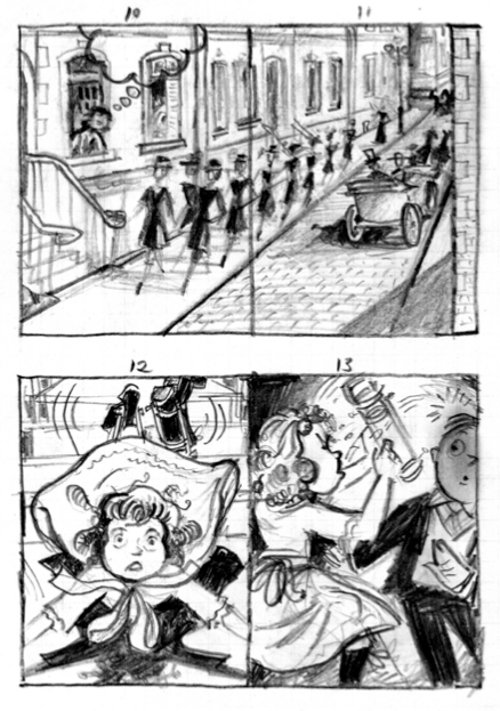
“Sometimes while she walked or ran, the braces would lock up, pitching Alice face-first to the ground. She did not want anyone saying
‘THE POOR LITTLE THING!’ about that, either.”
7-Imp: If you have illustrated for various age ranges (such as, both picture books and early reader books OR, say, picture books and chapter books), can you briefly discuss the differences, if any, in illustrating for one age group to another?
Edwin: I have, thus far, had two picture books published with a third coming in early 2010. They have all been historical biographies of characters that existed around the turn of the century (nineteenth to twentieth, that is) and are geared towards the same general readership: K-4.
I’ve been an editorial commercial illustrator since 1992 and had never contributed to children’s books before What To Do About Alice? in 2007. The process of creating a historical children’s picture book is unlike anything I’ve ever come across. I loved it, even though I found it to be daunting in scope. My commercial work has usually consisted of single-image narratives: quick visual precis statements that refer to either an event or a specific article. The children’s books I’ve done have been lengthy (for me) and linear. They are also different in that the art really has to expose the writing, and vice versa. By expose, I mean that some punch lines are carried solely in the art, with the writing creating a dry mechanism for the joke. I have found that there is much more conversation (reflection and contrast) between the art and text in these picture books, and I have a new respect for the difficult task of writing for these books. The writing must be extremely clever, concise, funny, and accurate. I’m glad there are others that are good at it.
Mermaid Queen: The Spectacular True Story of Annette Kellerman, Who Swam Her Way to Fame, Fortune, & Swimsuit History
(Scholastic, 2009)
“But swimming had made Annette’s legs strong. And in the water, she didn’t feel plain or clumsy or weak. She felt beautiful and graceful and fancy-free.”
7-Imp: Where are your stompin’ grounds?
Edwin: The beautiful, yet not self-adoring, Seattle, Washington.
7-Imp: Can you briefly tell us about your road to publication?
Edwin: I was lucky enough to have been asked in a phone call from my editor, Tracy Mack at Scholastic, to illustrate What To Do About Alice? by Barbara Kerley — in 2007. I said yes. I had never had previous interaction with anyone at Scholastic or in the world of children’s books in general. I had, however, contributed to periodicals such as the New Yorker since 1992, which may have had something to do with Tracy noticing my work.
7-Imp: Can you please point us to your web site and/or blog?
Edwin: www.edfotheringham.com/.
7-Imp: If you do school visits, tell us what they’re like.
Edwin: I’ve only done a visit to my kids’ (K-5) school, which was the scariest thing I’ve ever attempted. I loosened up after third grade, but I’ve got to say I felt sorry for the poor helpless kids that had to witness the strange sweaty man (I’d just arrived by bike, in haste), who couldn’t speak during long, pregnant pauses. Nothing, but nothing is more nerve-wracking than a group of second graders with high expectations. Not a job interview, nothing.
I can’t really relay what it was like, but I can say that I lived to write this answer. Just.
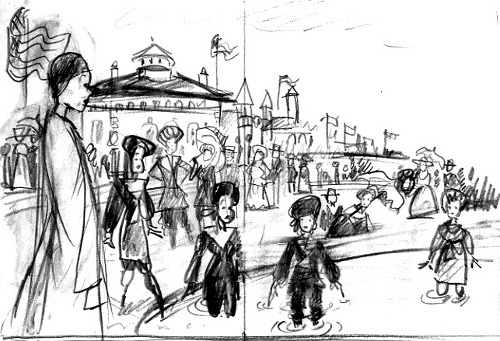
“How could anyone possibly swim in THAT?”
7-Imp: If you teach illustration, by chance, tell us how that influences your work as an illustrator.
Edwin: I have taught twice. The class was called “Illustration Concepts,” which is about the most vague title I’ve ever seen. The class was studio-length (3 hours), but not a studio class (in that we didn’t draw). It’s hard to have a critique for three hours, and it’s hard to speak (as in, to teach) to many levels of students in the same class. That said, I thought I did well for some, not so much for others. It’s subjective at both ends, really. I’m not sure it influenced my work, per se, but I did see some very promising stuff.
7-Imp: Any new titles/projects you might be working on now that you can tell us about?
Edwin: I just finished up The Extraordinary Mark Twain (According to Susy) by Barbara Kerley, which will be available in 2010, and I’m really proud of the whole thing. It involves an interesting design element that made figuring out the page layouts quite a challenge (in a good way), and I think it came together really well. I hope you feel the same way!
I am always working on whatever editorial and advertising work I can get my hands on. I’ve recently completed a slew of poster and ad illustrations for the Dutch Bike Company, who are located in Seattle and Chicago. I love riding bikes and really enjoyed working on these posters, which can be seen on my website. They’re cool.
 Our table’s set. Time for our breakfast chat. I thank Ed again for stopping by, and let’s keep at it…
Our table’s set. Time for our breakfast chat. I thank Ed again for stopping by, and let’s keep at it…
1. 7-Imp: What exactly is your process when you are illustrating a book? You can start wherever you’d like when answering: getting initial ideas, starting to illustrate, or even what it’s like under deadline, etc. Do you outline a great deal of the book before you illustrate or just let your muse lead you on and see where you end up?
Edwin: It’s exactly like this:
I get emailed a manuscript. I read it. I marvel at how short it is and how much work I have to do. I re-read the manuscript, and again. Then I talk briefly to the editor about general thoughts. Then I stew for a while (like, a month).
I look at the calendar and start to freak out a little. I start drawing very rough layout sketches to be presented to the editor and art director. Hopefully, I’m kind of getting into it by now, but I don’t expect great flashes of inspiration until the second draft. I just draw what the text seems to need. Some are good, some not. It doesn’t really matter, because I believe in starting with ONE sketch, not several ideas. I believe that the first draft is a conversation-starter. This book thing is a very collaborative process, and it’s good to start people thinking about how it could be better, or how something can be expanded on. So, I send the pages as I do them — at this stage, sometimes three or four spreads at a time.
“Soon Annette was racing her way through Europe.”
When all the rough, first-draft spreads are received, the editor and art director stew for about a month, and then send a really long bullet-pointed email with all of their suggestions. This is the part I love to hate or hate to love…anyhow, they come up with really thoughtful suggestions that add and subtract and divide and multiply my first response…and that’s when the art of the writing becomes special. When I can see what others see in the writing, my first pictorial response, and their reaction to all of it, I can really start to get into the groove. I can see the humor and detail in the writing that I could not see so well before. It’s like when I first see it, I’m blinded by the notion of how much work is in front of me. When a map is drawn, I can open my mind to nuance, and the art becomes much better for it. So onto the second draft, which is when I really enjoy myself. I do very close to finished art for this, because I feel more confident. This portion takes about a month-and-a-half or so to complete. I work late during this period, because I can’t stop in the middle. I send the art as I complete it, until it’s done. Another editorial review; another shorter, bullet-pointed email response.
Next, to finish. Then…the cover. The dastardly cover. This thing always kills me. Many cooks, many opinions. They’re very hard to please, but it always turns out.
Done.
The whole thing takes about three months, from start to finish. A year later, I get a printed book, and I honestly can’t believe how cool it is to have this thing in my hands.
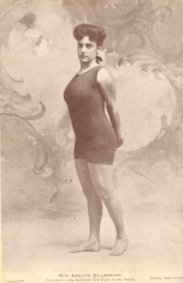 I have methods that I use to make the creative process easier for myself. I like to use visual systems that carry on through the entire book. These usually revolve around color palette, pattern, and rhythm. In Alice, I used a limited palette of about five main hues throughout the book and used graphic symbols (like dotted lines) to show movement and energy. I tried to create rhythm by alternating page layouts between full-bleed spreads, spots, and full-bleed single pages with a linked spot on the blank opposing page. I linked the whole book with a wallpaper pattern that I created to evoke the historical period.
I have methods that I use to make the creative process easier for myself. I like to use visual systems that carry on through the entire book. These usually revolve around color palette, pattern, and rhythm. In Alice, I used a limited palette of about five main hues throughout the book and used graphic symbols (like dotted lines) to show movement and energy. I tried to create rhythm by alternating page layouts between full-bleed spreads, spots, and full-bleed single pages with a linked spot on the blank opposing page. I linked the whole book with a wallpaper pattern that I created to evoke the historical period.
In Mermaid Queen, I similarly used pattern, color palette, and rhythm to tie the book together, to reflect the watery nature of the story. I found a picture of Annette Kellerman standing in her bathing suit in front of a kind of baroque-meets-art-deco backdrop, which I thought would make a great model for a pattern to symbolize water. I used it for more than water, though. It represents everything from applause to a damp London night sky. The color I used in Mermaid Queen was very saturated, with three main hues. I used an almost mathematical method to assign the colors. A spread could have a main color, blue, with a secondary color, green. The next spread would use the preceding green as the main color and have a secondary color, orange. The following spread would have orange as the main color; secondary color, blue; and so on. The book flows along like this all the way through, without too much consideration for the literal color of objects. When much of the story calls for drawings of a girl swimming, there needs to be something else going on to break things up, hence the pattern and color system.
2. 7-Imp: Describe your studio or usual work space for us.
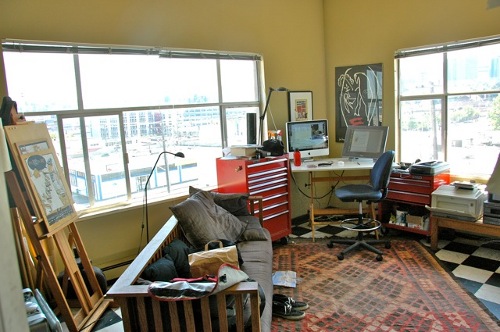

Edwin: I have done my family and myself the favor of having a studio outside the house. I don’t think I could work at home. I like to make distinctions between work, home, and play. So, I’ve got a separate space, and I keep regular hours. I try not to work weekends. I try not to work late. I come in at 9:00. It’s like I work at a really cool bank, with no supervisors. Furthermore, I’m the only one there, and I have a skateboard.

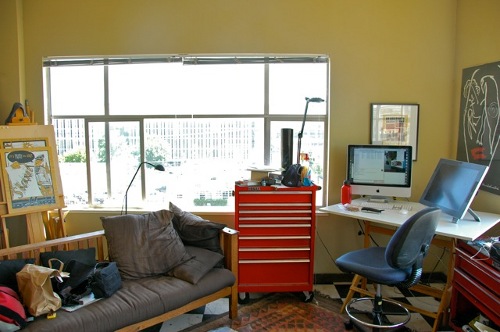

My studio is usually a mess. It’s not really like a studio where an artist works on art all over the place. It’s more like a messy office with two drafting tables, one which has a computer on it, the other has some old dried-up paint that gets used rarely, and bike maps all over it. There are pencils, pens, old ink, a scanner, a printer, drawing paper, and a loud stereo: all the mod cons, except a fridge. I do, however, have a couch that I built years ago. It was deemed too uncomfortable to sit on. It is very comfortable to nap on, and to throw stuff on, which I do (mostly the latter). I have old artwork on all of my walls to remind myself of past triumphs and failures, many pictures of my family, and one of me skateboarding. (It makes me happy, because I am both petrified of—and in love with—skateboarding.) I have a few pieces by some other artists, too, because it’s weird to only look at your own work. (But I don’t have too many, because I can’t help but want to look at my own work.) I don’t have air conditioning, and today I want it. I have tons of books that sit on packed shelves, and I have flat files filled with drawings, posters, and ephemera. I keep all my drawing and obsolete computer stuff in mechanics’ tool drawers. I will say that this is THE BEST studio drawer system available. Look no further. It rolls around (if you want), and it’s belly-button-high, if you need a standing palette or something to lean on.
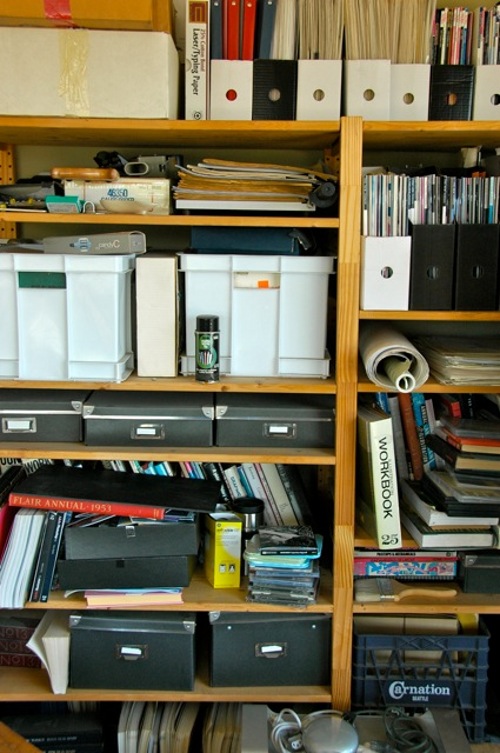
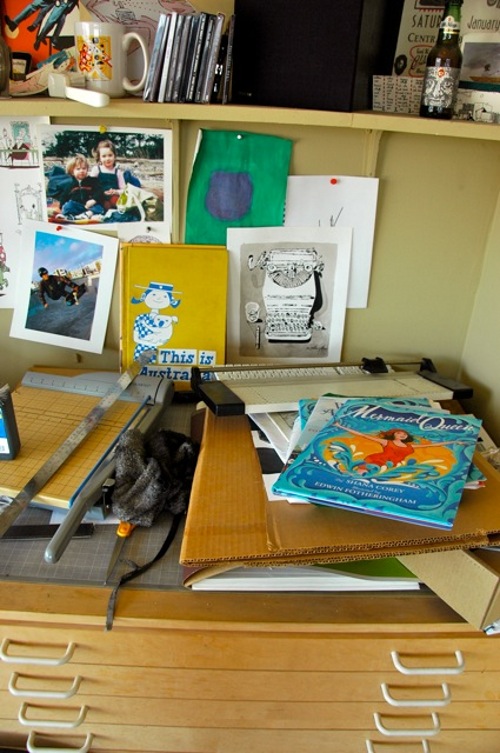
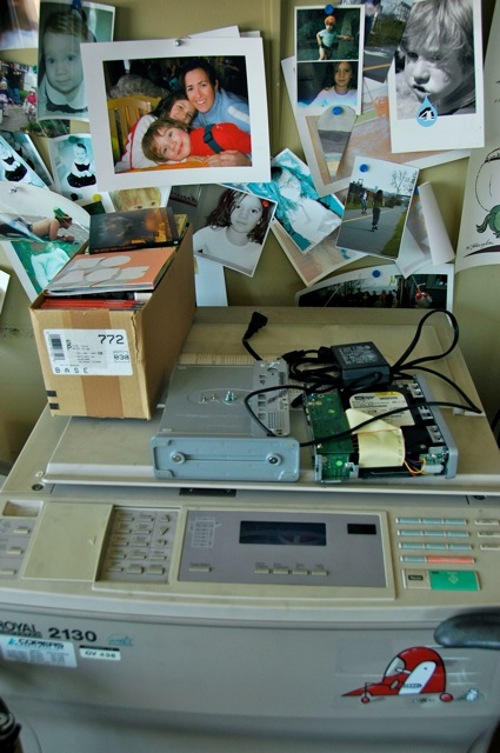
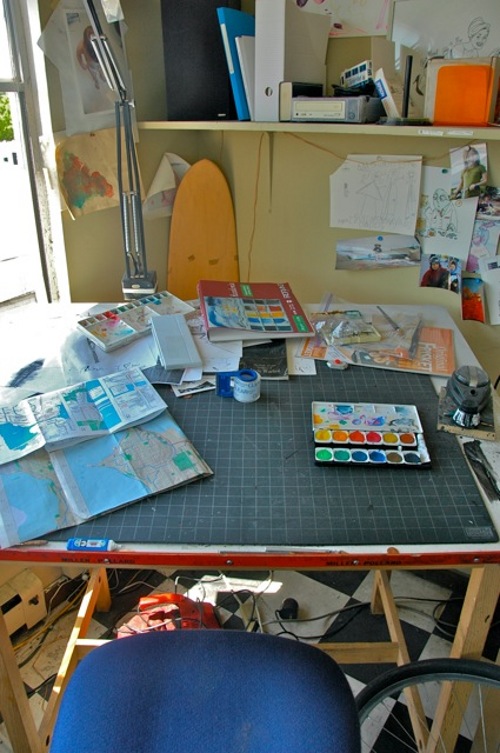
I pay very little rent and have a fourth-floor space with views of downtown Seattle, the Space Needle, Capitol Hill, and Lake Union. It’s sweet. I haven’t left in eleven years, and they’re going to have to drag me out.
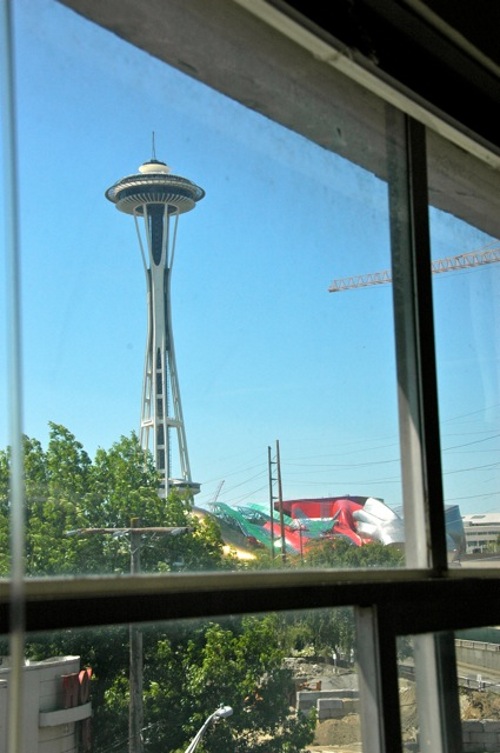

3. 7-Imp: As book lovers, it interests us: What books or authors and/or illustrators influenced you as an early reader?
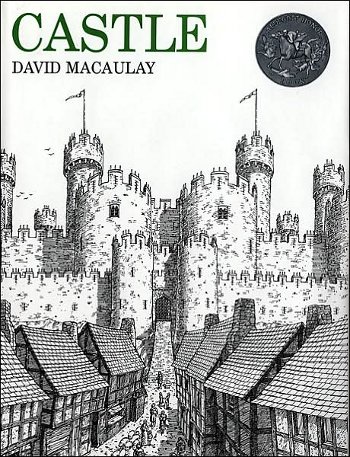 Edwin: I have to be honest and tell you that I was the sort who read only what was in italics (as in, the captions under the pictures). I’ve always loved looking at pictures. I’ve always loved drawing pictures, too, but mostly I love looking at them. So, as an early viewer of pictures and reader of italic type, I will say that I was fascinated and enthralled by: most everything Dr. Seuss did for its illustrative (and, o.k., I’ll admit it, written) wonderment; all of those David Macaulay books (City, Cathedral, Pyramid, Castle, and Underground) that were spectacles of detail and draftsmanship par excellence; Where the Wild Things Are by Maurice Sendak; World Book Encyclopedia, Volume S (the really big one — lots and lots of italic type); any of the Chuck-Jones-era Warner Bros. cartoons (mainly for the backgrounds): they’re not books, but they were a HUGE influence on me; and there was an illustrated book about Seattle, for which I can’t, for the life of me, remember the title or author. I had it while I was growing up in Sydney, and it reminded me of Seattle, where my Dad lived. It looked like those Sasek city books, but it was about Seattle. I’d never seen the Sasek books as a child, and remembering the Seattle book, I know that they would have blown me away.
Edwin: I have to be honest and tell you that I was the sort who read only what was in italics (as in, the captions under the pictures). I’ve always loved looking at pictures. I’ve always loved drawing pictures, too, but mostly I love looking at them. So, as an early viewer of pictures and reader of italic type, I will say that I was fascinated and enthralled by: most everything Dr. Seuss did for its illustrative (and, o.k., I’ll admit it, written) wonderment; all of those David Macaulay books (City, Cathedral, Pyramid, Castle, and Underground) that were spectacles of detail and draftsmanship par excellence; Where the Wild Things Are by Maurice Sendak; World Book Encyclopedia, Volume S (the really big one — lots and lots of italic type); any of the Chuck-Jones-era Warner Bros. cartoons (mainly for the backgrounds): they’re not books, but they were a HUGE influence on me; and there was an illustrated book about Seattle, for which I can’t, for the life of me, remember the title or author. I had it while I was growing up in Sydney, and it reminded me of Seattle, where my Dad lived. It looked like those Sasek city books, but it was about Seattle. I’d never seen the Sasek books as a child, and remembering the Seattle book, I know that they would have blown me away.
4. 7-Imp: If you could have three (living) illustrators—whom you have not yet met—over for coffee or a glass of rich, red wine, whom would you choose?
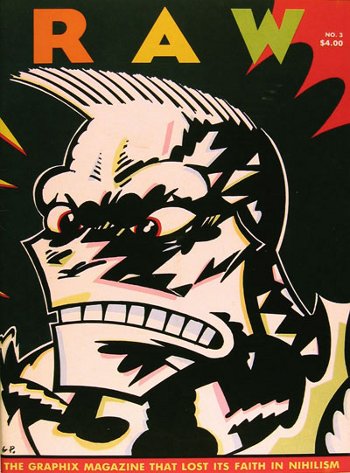 Edwin: Istvan Banyai, Gary Panter (met him once, very quickly, and not enough to say “I knew him,” so I say he counts), and Drew Friedman. Might be an interesting time. Might be a dud. Who knows? In all honesty, though, the illustrators that I have met tend to really like one another, in a “more the merrier” sort of way. So I think it would be fun.
Edwin: Istvan Banyai, Gary Panter (met him once, very quickly, and not enough to say “I knew him,” so I say he counts), and Drew Friedman. Might be an interesting time. Might be a dud. Who knows? In all honesty, though, the illustrators that I have met tend to really like one another, in a “more the merrier” sort of way. So I think it would be fun.
{Ed. Note: Pictured here is cover art work for RAW by Gary Panter.}
5. 7-Imp: What is currently in rotation on your iPod or loaded in your CD player? Do you listen to music while you create books?
Edwin: I like to listen to fairly avant-garde rock from the late seventies and eighties. I like bands like The Fall, Pere Ubu, Can, Devo, The Birthday Party, Gang of Four, etc. etc. etc. It’s pretty normal stuff for people of my vintage, who weren’t in fraternities.
6. 7-Imp: What’s one thing that most people don’t know about you?
Edwin: I was in several very bad punk bands in the eighties. Actually, a few people know this, just not necessarily the ones reading this blog. I’ve led a rich and varied life.
7. 7-Imp: Is there something you wish interviewers would ask you — but never do? Feel free to ask and respond here.
Edwin: Q: How much do you like spare ribs?
A: A lot!
7-Imp: What is your favorite word?
Edwin: “Yes,” or “no” (depends).
7-Imp: What is your least favorite word?
Edwin: “No,” or “yes” (depends).
7-Imp: What turns you on creatively, spiritually or emotionally?
Edwin: Humorous cynicism.
7-Imp: What turns you off?
Edwin: I don’t really have a favorite, or least favorite, word. I am, however, currently annoyed by the phrase “It’s all good,” which I usually take to mean the opposite. That tends to turn me off.
7-Imp: What is your favorite curse word? (optional)
Edwin: I find cursing necessary to get through the day. No favorite.
7-Imp: What sound or noise do you love?
Edwin: Genuine laughter from any age group.
7-Imp: What sound or noise do you hate?
Edwin: Fake laughter from any age group.
7-Imp: What profession other than your own would you like to attempt?
Edwin: Self-employed neighborhood window washer (Paddington, NSW, Australia)
7-Imp: What profession would you not like to do?
Edwin: Coroner (anywhere).
7-Imp: If Heaven exists, what would you like to hear God say when you arrive at the Pearly Gates?
Edwin: “Welcome, whatever you believe!”
Illustrations from What to Do About Alice?: How Alice Roosevelt Broke the Rules, Charmed the World, and Drove Her Father Teddy Crazy! copyright 2008 by Edwin Fotheringham. Used with permission from Scholastic Press.
Illustrations from Mermaid Queen: The Spectacular True Story of Annette Kellerman, Who Swam Her Way to Fame, Fortune, & Swimsuit History copyright 2009 by Edwin Fotheringham. Used with permission from Scholastic Press.
All sketches, all studio images, and the opening photo courtesy of Edwin Fotheringham. All rights reserved.
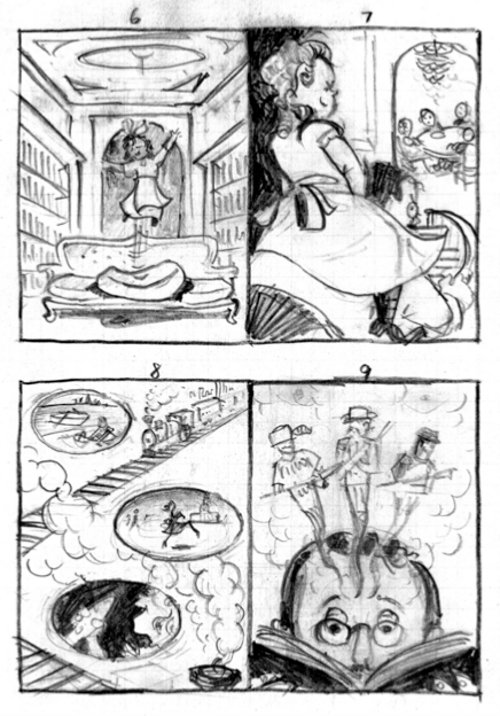
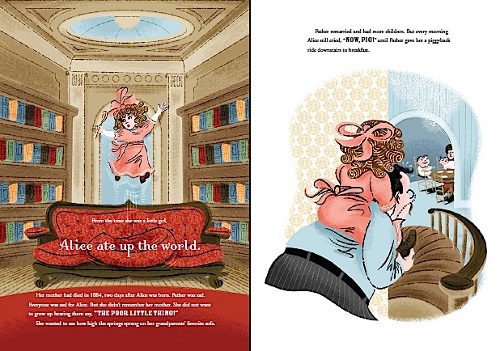
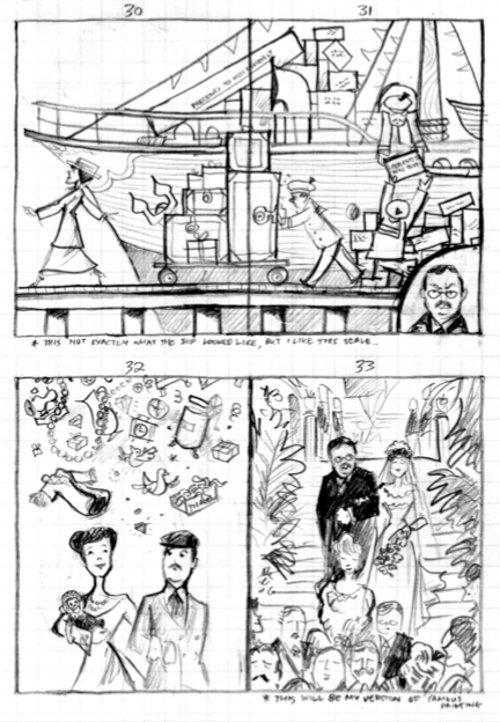


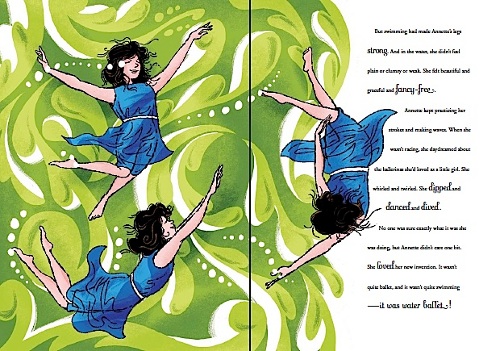
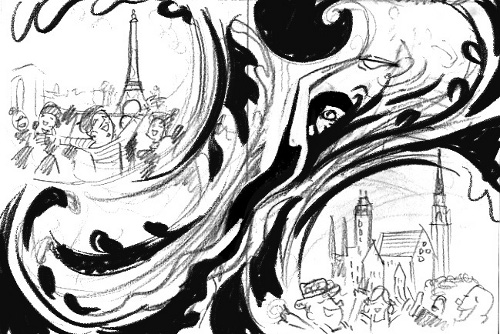
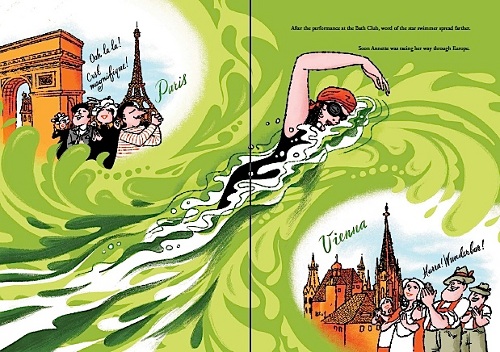

Absolutely beautiful. The motion, the color, the line. Are you still creating the outline with ink then scanning it in or do you get that inky irregular line from photoshop?
Jules! I’m sitting on the edge of my chair waiting for the Pamela Zagarenski profile, and then you non-nonchalantly slide in Edwin Fotheringham?! I fell OFF the chair. And he’s charming and funny too- delightful breakfast- thank you!
His work is just exhilarating to experience. I love, love, love it. I was an instant fan with the Alice book and my admiration went up several notches with the Mermaid Queen. Can’t wait to see the Twain book!
Hi, guys. Boni, Pamela Z. comes next week. Promise! Glad you’re looking forward to it. I’ll have to seriously devote some time just to formatting the tons of images she sent, but it’ll be worth it.
Glad you all enjoyed this. It was a pleasure to format. I was laughing outloud at some of his responses — and oohing and aahing over his art.
Thanks for another fab interview. Was very generous of Ed to answer questions in detail and provide lots of great photos. Love his distinctive style!
Edwin: Hello, fellow Seattle-dweller! I’m looking forward to checking out your books. The Mermaid Queen in particular will be of interest to my 6 year old daughter.
I’m with you on the fake-laughter. It brings to mind a gig I did last summer where I just said off-handedly, “This is kind of a silly song” and then the class did loud, fake laughing that was borderline offensive. The teacher shushed them, and I actually stopped the song, said, “I don’t think I was THAT funny” and went on. The rest of the gig went pretty well. (Oh, and every time I took a sip of water, that same audience also said, “Ewww” until I pointed out that I wasn’t spitting into my water. They found that funny, and then they stopped it.)
–Farida
When our five-year-old fake-laughs (“Barney” laughs, we call them), the rule in our house is that she gets tickled, therefore evoking the real laughs that make life so good.
This interview looks sooooo meaty . I will start/fav/star it for later this evening as my evening reading…I have to get some work done!
I am very impressed at what I have seen skimming over it and your documentation by photo is so satisfying to the inquiring eye. I love what you have done so far…and will get back to you later once read.
Wow, another kick-ass interview. Love seeing the sketches and their finished inked versions, and that studio makes me drool all over my boring, boring, boring home office, where I create boring, boring, boring web pages all day. Seriously, these artist profiles are the best possible motivation to get on with the business of creating the best possible life.
Re: blotted line; I have made a brush in Photoshop that closely resembles the real thing. I stopped doing the actual blotted line when I got my Wacom Cintique (the pressure sensitive pen input monitor). It’s a bit lazy on my part, but it works for me.
I’m heartened to hear that many people loathe fake laughter. HA! (real).
*happy sigh* Am now in love with Ed Fotheringham, the person, and not just his art. (You know I adored MERMAID QUEEN, I’m guessing, from my review.) I love that other people (besides myself) have to swear to get through the day. Seriously a great interview.
REALLY beautiful work Ed, and great interview! Cannot wait to read through Mermaid Queen!
Beautiful work- I love the design, and seeing the sketch-to-finish transition. Oh yes, and I have serious studio envy now!
Ed, you make the world a cooler and funnier place, and may I say you do it with a very cool bike as well : )
-Blair and Peter
I’m with the “I’m in love with Ed” team, and have been for 20 some odd years.
What a great spirit and soul.
What a wonderful interview with
such a talanted young man – this comment comes from his Aunt in Sydney, Australia, who is so proud of him and his exceptiional work – Eddy you are sensational – Love you !!!
[…] really enjoyed 7 Imp’s interview with Edwin Fotheringham, in part because I like to say the name “Edwin Fotheringham,” because it makes me feel […]
dad you are really good and cool. you are the best dad anyone could ever ask for. I love you and see you at dinner. cool website!
Anna
Fabulous interview! I love Ed’s artwork, but don’t have the correct vocab to describe how I feel, not being an artist. I must admit that I don’t usually think much about illustrators, even though I always enjoy the pictures! This has really opened up my eyes.
Y’know, I actually read this interview twice yesterday. Y’know what else? Both times I left dumbfounded and comment-less at the generosity of both 7-Imp’s interviewees (Ed Fotheringham!) and of course 7-Imp itself. I mean, come on — this is close to five thousand freaking words long. How amazing is that?
(Also couldn’t help noticing there was no link back to your earlier review of The Mermaid Queen and interview with the author Shana Corey from exactly a month ago today, which first got all of us here stirred up about it. Perhaps some OCD-ridden reader will correct that for you.)
Mr. F’s reply to your first question, the numbered “What exactly is your process?” one, together with the earlier “What is your usual medium?” question, was almost breathtakingly complete. It made ME want to be an artist, just so I could be that cool.
(It’s really really hard to make “I type, and stare into space a lot” anywhere near that interesting.)
That he was so taken with Miroslav Sasek’s work and with David Macaulay’s can make one hope (not in vain?) that he maybe, just maybe would fold those interests, and his childhood memory of the Seattle book, into his own book on the city. I’ve never been there but can, in my mind’s eye, picture really beautiful pages illustrated with his fluid lines and generous backgrounds.
Three last things:
(1) Man, I’d love to have known Alice Longworth Roosevelt.
(2) How cool is it to find a comment here by one of Ed’s kids?!?
(3) Ed’s NYer illustration of Stephen Colbert was one of my favorites in decades of subscribage. Like some of the work by MAD Magazine‘s Mort Drucker, in that single image Ed manages to capture pretty much everything that makes Colbert so appealing and recognizable. The rubbery pencil is a perfect touch!
Great interview, Jules. Great answers, Ed. Great comment, Anna!
As someone just beginning on the path to becoming a Children’s Book Illustrator, I would like to thank Mr. Fotheringham for being so detailed in this interview. Particularly about the process, the relationship that he and his editor have in developing the book and his ideas on connecting his images to create a cohesive visual story.
I can’t express enough my gratitude for your generosity.
Okay, I wouldn’t have expected anything less than a great interview with Ed. I thought it was great to see that he had a copy of M. Sasek’s This Is Australia and it made me wonder if he wasn’t the perfect person to pick up that series and take on some of the International cities Sasek didn’t get to in his lifetime. Hmm. I think I’ll write to him and suggest it…
I went wild over Mermaid Queen based on the cover alone, bought it and have it placed in my office so I can see it everytime I look up…and now what a gift to be able to read this treasure of an interview. Thank you both!
[…] Raina Telgemeier (Smile), Bruce Degen (The Magic School Bus), Barbara McClintock (Our Abe Lincoln), Ed Fotheringham (Tony Baloney), David Shannon (No, David!), Jeff Smith (Bone), Sean Qualls (Dizzy), Mark Teague […]
[…] Barbara Kerley’s A Home for Mr. Emerson (Scholastic, February 2014), illustrated by Edwin Fotheringham, and Susan Goldman Rubin’s Everybody Paints!: The Lives and Art of the Wyeth Family (Chronicle, […]
[…] at very young children — Jennifer Hamburg’s Monkey and Duck Quack Up!, illustrated by Edwin Fotheringham (Scholastic, February 2015); Doreen Cronin’s Smick!, illustrated by Juana Medina (Viking, […]